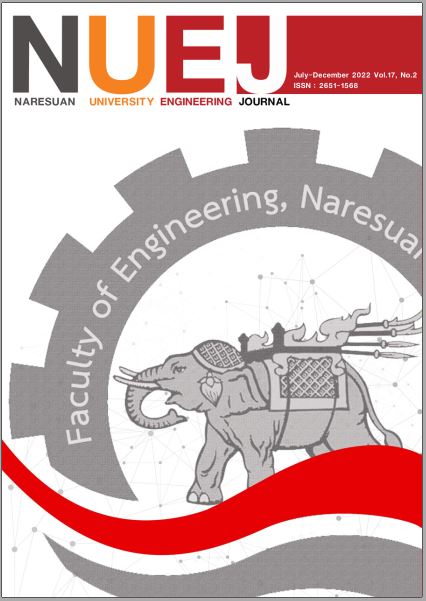Evaluating Hydroelectricity Production Re-operating with Adapted Rule Curve Under Climate Change Scenarios: Case Study of Bhumibol Dam in Thailand
Main Article Content
Abstract
Hydroelectricity production is being impacted by climate change due to the considerable changes in water availability of reservoir system and dam release. This study aims at evaluating the response of energy production of the Bhumibol dam through the reservoir re–operation system with non–engineering adaptation measures due to climate change. Re–operating the Bhumibol (BB) dam with adapted rule curve and modelling exercise with MIKE11 to predict series of reservoir inflow were conducted under RCP4.5 and RCP8.5 climate change scenarios. The adapted rule curves of BB dam were established by either increasing or lowering the upper and lower rule levels of 0.5 meters from the rule curves which were developed by EGAT in 2012. In addition, the standard operation policy was applied to specify the amount of water release corresponding to the adapted rule curves established. The water balance–based reservoir re–operation model was developed using MATLAB Simulink Toolbox for short–term simulation from 2012 to 2018. Influence of climate change on the seasonal and yearly reservoir inflows were considerably investigated. In addition, the relation of current and projected inflows, and the response of dam release and hydroelectric production of BB dam were then evaluated. The results of the short–term simulation from 2012 to 2018 show that dam release is likely to be increased corresponding to the high variability of projected inflows. Therefore, the seasonal and yearly hydroelectricity production are accordingly increased when re–operating dam under RCP4.5 and RCP8.5 inflows. It is found that the yearly hydroelectricity production with RCP4.5 and RCP8 inflows are about 52% and 30% respectively higher than the current inflow. It is also revealed that re–operating dam with the different types of adapted rule curves does not alter the volume of released water and energy production generated from the reservoir radically because the standard operating rules were adopted for all adapted rule curves. Importantly, the study on the adaptation measures to climate change would help increase understanding of necessity of new operational rules for dam and reservoir re–operation to cope well with instability of reservoir water supply for sustainable hydropower production in future.
Article Details

This work is licensed under a Creative Commons Attribution-NonCommercial-NoDerivatives 4.0 International License.
References
Aroonrat, K., & Wongwises, S. (2015). Current status and potential of hydro energy in Thailand: A review. Renewable and Sustainable Energy Reviews, 46, 70–78. https://doi.org/10.1016/j.rser.2015.02.010
ASEAN Development Bank. (2012). Climate risk and adaptation in the electric power sector. Retrieved from http://hdl.handle.net/11540/887.
Carvajal, P. E., Anandarajah, G., Mulugetta, Y., & Dessens, O. (2017). Assessing uncertainty of climate change impacts on long–term hydropower generation using the CMIP5 ensemble–the case of Ecuador. Climatic Change, 144(4), 611–624.
Davis, R. B., & Mukamal, K. J. (2006). Hypothesis testing: means. Circulation, 114(10), 1078–1082. https://doi.org/10.1161/CIRCULATIONAHA.105.586461
Goyal, M. K., & Surampalli, R. Y. (2018). Impact of climate change on water resources in India. Journal of Environmental Engineering, 144(7), 04018054.http://doi.org/10.1061/(ASCE)EE.1943–7870.0001394
Jia, J. (2016). A technical review of hydro–project development in China. Engineering, 2(3), 302–312.
https://doi.org/10.1016/J.ENG.2016.03.008
Kangrang, A., Prasanchum, H., & Hormwichian, R. (2018). Development of future rule curves for multipurpose reservoir operation using conditional genetic and tabu search algorithms. Advances in Civil Engineering, Article ID 6474870, 1–10.http://dx.doi.org/10.1155/2018/6474870
Kundzewicz, Z. W., Kanae, S., Seneviratne, S. I., Handmer, J., Nicholls, N., Peduzzi, P., & Sherstyukov, B. (2014). Flood risk and climate change: global and regional perspectives. Hydrological Sciences Journal, 59(1), 1–28.https://doi.org/10.1080/02626667.2013.857411
Kyaw, K. M., Rittima, A., Phankamolsil, Y., Tabucanon, A. S., Sawangphol, W., Kraisangka, J., Talaluxmana, Y & Vudhivanich, V. (2022). Assessing Reservoir Reoperation Performances through Adapted Rule Curve and Hedging Policies under Climate Change Scenarios: In–depth Investigation of Case Study of Bhumibol Dam in Thailand. Engineering Access, 8(2), 179–185. http://doi:10.14456/mijet.2022.23
Labovitz, S. (1970). The nonutility of significance tests: The significance of tests of significance reconsidered. Pacific Sociological Review, 13(3), 141–148. https://doi.org/10.2307%2F1388411
Neelakantan, T. R, & Sasireka, K. (2013). Hydropower reservoir operation using standard operating and standard hedging policies. International Journal of Engineering and Technology, 5(2), 1191–1196. https://citeseerx.ist.psu.edu/viewdoc/download?doi=10.1.1.412.1094&rep=rep1&type=pdf
Punarai, N., Khumkaew, S., & Kluabwang, J. (2015). Application of differential evolution to parameter identification of Bhumibol Hydro Power Plant in Thailand. Proceedings of the International MultiConference of Engineers and Computer Scientists.
Raftery, A. E., Gilks, W. R., Richardson, S., & Spiegelhalter, D. (1995). Hypothesis testing and model. Markov chain Monte Carlo in practice, 165–187.
St, L., & Wold, S. (1989). Analysis of variance (ANOVA). Chemometrics and intelligent laboratory systems, 6(4), 259–272.https://doi.org/10.1016/0169–7439(89)80095–4
Tabucanon, A. S., Rittima, A., Raveephinit, D., Phankamolsil, Y., Sawangphol, W., Kraisangka, J., Talaluxmana, Y., Vudhivanich, V., & Xue, W. (2021). Impact of climate change on reservoir reliability: a case of Bhumibol Dam in Ping River Basin, Thailand. Environment and Natural Resources Journal, 19(4), 266–281. http://dx.doi.org/10.32526/ ennrj/19/2021012
Thongthamchart, C., & Raphitphan, N. (2016). Performance of Bhumibol concrete arch dam after 50 years of operation. EGAT, Thailand. In: Proceedings for ASIA. https://www.academia.edu/25900993/Performance_of_Bhumibol_concrete_arch_dam_after_50_years_of_operation


